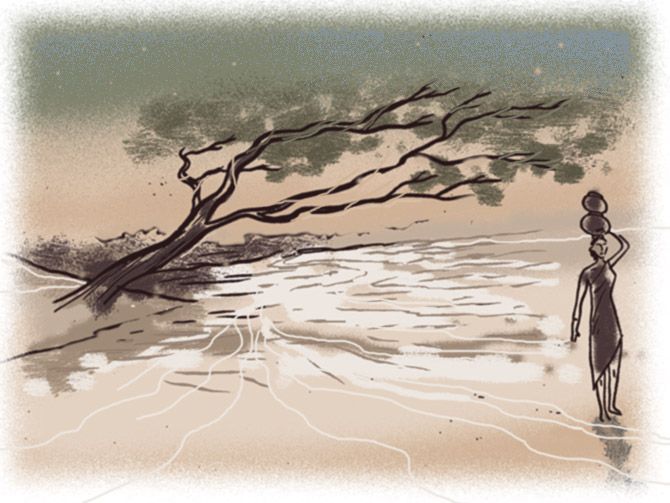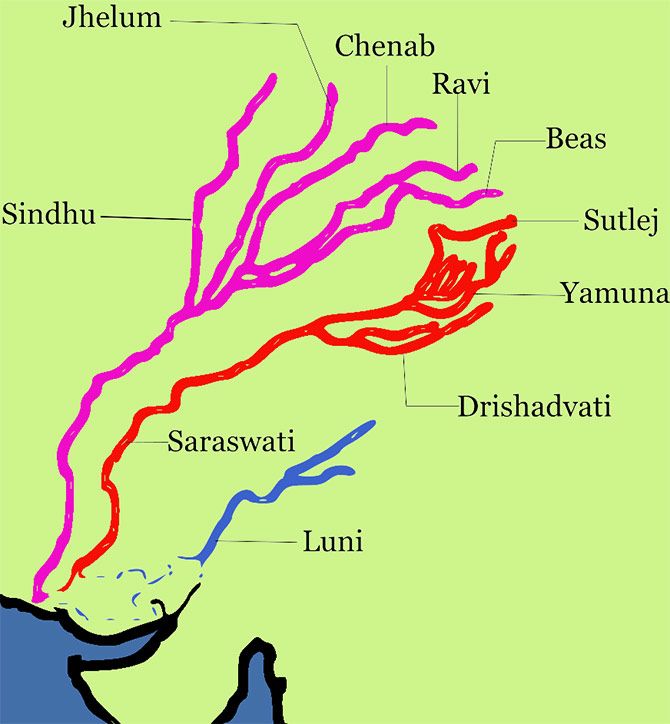This Haryana village believes it has 'found' the Saraswati river of the Vedas.
Manavi Kapur reports.
Illustration: Dominic Xavier/Rediff.com

"You are only just finding out. Our ancestors have known for ages that the Saraswati flows here," proclaims Rajeshwar Shastri, head priest at the Kedarnath temple in Adi Badri, Haryana.
This is the site that he, and a growing tribe of the faithful, believes to be the origin of the 'lost' Saraswati. His conviction, he says, owes to the years he spent as a Vedic scholar at Banaras Hindu University.
"I am not a pandit, I am a Brahmin. I have read the Vedas and the Puranas and I can tell you with confidence that the river that flows here is the Saraswati,"
Shastri's views may seem bizarre, especially given the fact that even Hindu mythology deems the Saraswati lost several thousand years ago. But that the mythical river is significant to Hindus has been reason enough for archaeology expeditions to be sanctioned in the Rajasthan-Haryana belt.
Many believe that the Saraswati holds the key to understanding the Indus Valley and Harappan civilisations. But, most importantly, finding the river will offer proof that the Indo-Aryans were the 'original' inhabitants of this region, especially since Hindu scriptures support that claim.
Governments in the past, including 'secular' Congress-led central and state ones, have dedicated efforts to looking for evidence that the Saraswati did indeed once exist.
Most efforts hit a dead end noiselessly, but policymakers persisted.
Eventually, they achieved 'success' in 2015, in Mughalwali, a tiny hamlet in Yamuna Nagar contiguous with Adi Badri. The Saraswati 'rejuvenation' team, set up in 2015 under Haryana's new Bharatiya Janata Party government, had started excavating farmland and 'found' water at seven feet.
Here, they felt, was the proof they were looking for.
The government has officially announced Rs 500 million for this project.
Early this year, an annual 'ancient' mela received a strong push. Visitors were ferried in buses that sported banners that read 'Saraswati ki kahaani, vigyaan ki zubaani (The story of Saraswati through the voice of science)'.
The mela also included symposiums to debate the course of the river. OB vans were parked in Adi Badri and the villages of Yamuna Nagar for days on end.

The excavations gained momentum.
"According to our scriptures, when Ved Vyas and Ganesha sat on the banks of the Saraswati to write the Mahabharata, the sage asked the river goddess to flow more gently. She didn't listen and that is when Ganesha cursed her that she will one day completely vanish," explains Dharmender Pandey, a priest at the Adi Badri temple.
Between evading uncomfortable questions, he chants mantras, breaks a banana in half for prasad and warns visitors of monkeys outside.
"People from all over Punjab and Haryana come and visit the spot where the Saraswati originates. We now see more devotees than ever before," he says, finally.
On a Monday afternoon, besides a handful of priests and Vedic scholars, the temple and its surroundings are deserted. So when is the peak season?
"Jab bhagwaan bulaayenge (Whenever the gods summon)," he smiles. "See, even if you don't believe the scriptures, scientists from NASA (National Aeronautics and Space Administration) and ISRO (Indian Space Research Organisation) have verified that this is the Saraswati," he says.
Shastri, from the temple across the river, agrees: "They even tested the water from here and found it had the highest oxygen content. We knew this about the Saraswati. The water here has healing powers because of the special bacteria and the oxygen."
But neither Shastri nor Pandey, nor anyone else in Adi Badri, are able to cite the 'scientific' findings. 'If the government is willing to spend Rs 2.5 billion to Rs 3 billion on building check-dams and reviving the river, then they must have found good reason to do so," is all Shastri can offer.
This claim echoes through the entire Saraswati-finding community.

For instance, the Haryana Sarasvati Heritage Development Board, set up in 2015, lists ISRO, leading Indian Institutes of Technology, the Bhabha Atomic Research Centre and the Archaeological Survey of India as affiliated organisations. Nearly 70 such organisations 'work' with the board, but the scope of work remains unspecified.
The HSHDB Web site details 'anecdotes' from Hindu mythology to substantiate its 'scientific evidence', all of it couched in convoluted sentences and accompanied by questionable academic references.
This uncomfortable and unlikely convergence of science and mythology, of belief and physical evidence, and of politics and archaeology is the subject of a wry documentary, Searching for Saraswati.
Directed by Amit Madheshiya and Shirley Abraham, this is the first Indian film selected as part of The New York Times's Op-Docs series.
"I was always fascinated by this river project. I was curious both about the search for the Saraswati as well as the motivation behind it," says Madheshiya.
He read across opposing sides of the debate to understand how fact and mythology came together. He read Michel Danino's The Lost River (2010), which argued for the existence of the river. Saraswati-believers trace this school of thought to British India's geological surveyor, Richard Dixon Oldham, who, in 1886, said that the seasonal river Ghaggar was, in fact, the Saraswati.
Madheshiya read historian Irfan Habib's views on the unexplained need to 'look' for the river. In a 2015 article for The Hindu, Habib explains the obsession with the Saraswati as a purely nationalistic sentiment.
'The Indus Valley Civilisation, whose two major cities Mohenjo Daro and Harappa unfortunately lie in Pakistan, can then be renamed the Saraswati Civilisation and, on that ground, claimed for India.'
The film itself offers an unsettling view of blind faith and a rumour mill being fed by local authorities.
Other, more sceptical, voices, counter peculiar ideas that the water from this 'river' can cure leprosy.
'How can this still water be a river?' asks one village woman.
But the faith factory has taken off and beliefs are enacted through fabricated festivals and rituals.
Almost 50 women, dressed in red to please the goddess, gather around the supposed pond and pray for the wellbeing of their husbands.
Childless couples are asked to drink water from the 'river' pond and there is talk of a charitable organisation to promote the cause of the Saraswati.
When news of the 'found'river broke out in 2015, Panipat-based Pooran Prakash Kapoor filed an RTI with the Haryana government demanding proof. "I got no response for months and decided to take it to court."
Finally, the court directed the district development and panchayat officer, Gagandeep Singh, to furnish these details.
What emerged was ludicrous: The excavation to recreate the river channel was being carried out on the basis of land revenue records from the Mughal era.
"If you are taking water from tubewells, water that is key for irrigation, and redirecting it to some unsubstantiated river, the motive is clear. This is an activity just to mobilise the Hindu vote bank," says Kapoor.
His RTI request was finally directed to Akshay Rajan Chaudhri, head of the Centre of Excellence for Saraswati set up at Kurukshetra University in Haryana.

Chaudhri proves to be a fount of confident ,em>non sequiturs. "Our mandate is to carry out a multi-disciplinary research around the Saraswati. This includes scriptural, archaeological, indological and geological information," he says.
The geology professor has been associated with Saraswati research since 2002, when, he says, this field of inquiry was often termed "foolish".
"There were different shades of international scientists and media that termed this an agenda-driven exercise. Our centre was set up to thwart these uninformed claims," he says.
But when asked about the evidence collected thus far, he is resolutely opaque: "There is evidence of a massive trans-Himalayan river system. But there is very little original research and I cannot comment before it is published officially."
In Adi Badri, a gate and a green sign-board proclaim this site as the origin of the Saraswati.
Water trickles down a small gau-mukh (a structure common in Hindu temples where a cow's mouth is used as a spout), creating a channel for the brownish stream to flow into a pond.
A nifty little Haryana Tourism guest house, usually frequented on weekends, overlooks a large step well inaugurated by Haryana Chief Minister Manohar Lal Khattar in January this year.
When Harish Rawat, caretaker of the guesthouse, is asked if he believes this is water from the Saraswati, he chuckles and looks at the skies.
"This is rainwater," he says.










